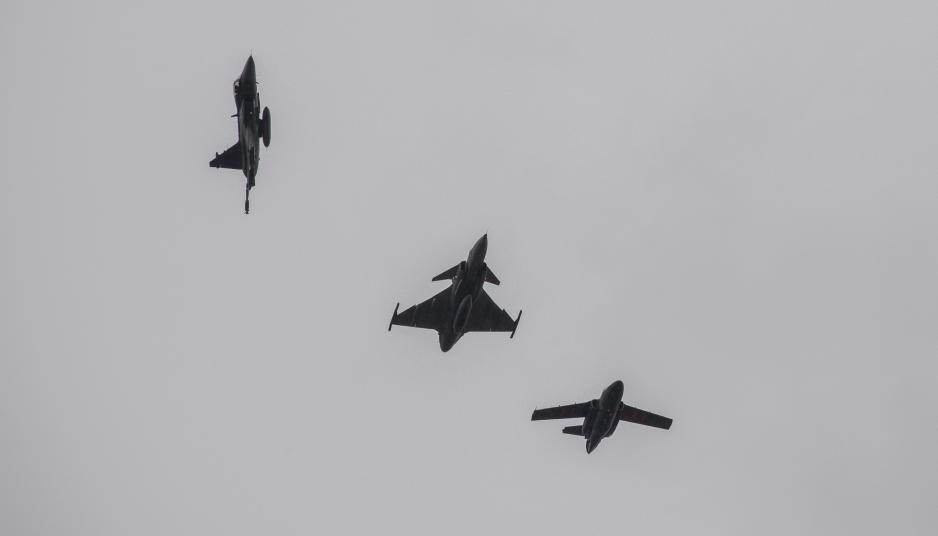Arctic Challenge Exercise 2023: 150 Aircraft Will Train In the High North

The Arctic Challenge Exercise was last organized in 2021: Here, an American F-16 fighter jet is breaking out of an formation of Swedish aircraft at the Luleå-Kallax Air Base in Northern Sweden. (Photo: Ali Stewart/US Air Force)
At the end of May, the large-scale fighter jet exercise Arctic Challenge Exercise will begin across Norway, Finland, and Sweden. The main activity will take place in the High North – and will include the first major F-35 exercise in Europe.
The Nordic fighter jet exercise Arctic Challenge Exercise (ACE) will take place from the 29th of May to the 9th of June.
Around 150 aircraft and 3000 persons from 14 countries are to train across the host countries Norway, Finland, and Sweden – mainly over the countries' northern regions. In Northern Norway, the activity will primarily take place in an area off the Helgeland coast.
ACE has been organized under Norwegian-Finnish-Swedish auspices biannually since 2013 and is part of the Nordic defense cooperation NORDEFCO.
As with previous editions, other countries are also participating. Participants in this year's exercise include Denmark, the USA, Canada, the UK, Germany, the Netherlands, France, Belgium, Switzerland, the Czech Republic, and Italy. NATO will also participate with aircraft equipped with the Airborne Warning and Control System (AWACS).
This will be one of the largest air exercises in Europe in 2023 – and the first major exercise with the F-35 fighter jets in a European context. These fifth-generation fighters will participate from Norway, the USA, the UK, the Netherlands and Italy. This is also the first ACE edition with Finland as a NATO member.
Finnish exercise leadership
ACE will be based out of four airbases: Rovaniemi in Northern Finland, Pirkkala in southwest Finland, Luleå-Kallax in Northern Sweden, and Ørland in central Norway.
Finland has the main responsibility for this year's exercise, led by the Finnish Air Force's Deputy Chief of Staff Operations, Colonel Henrik Elo. Colonel Carl-Fredrik Edström and Colonel Andreas Johansen from the Swedish and Norwegian air defenses, respectively, are second in command.
"The Arctic Challenge Exercise is now well established as a Nordic exercise concept which, in its current form, provides the participants with the opportunity to develop cooperation between fourth and fifth-generation fighter jets and advanced air defense systems. The exercise area is extensive, which enables training for tactically challenging scenarios with a large number of aircraft," says Elo in a press release.
The purpose of the ACE is to strengthen the participants' ability to carry out combat tasks within large multinational air operations in a safe and effective manner. Furthermore, aerial combat methods and tactics are developed between the various types of fighter jets. In addition to F-25, the exercise will include fighter jets of the type F-16, JAS Gripen, and F/A-18 Hornet – as well as liaison, transport, and tanker aircraft.
Through the border-crossing concept, interoperability, arrangements for host country support, and receiving of international assistance are also practiced.
Previous editions
This year's version of ACE will be the largest one yet. Participation in the previous editions was as follows:
- ACE 2021 (pandemic year): Around 70 aircraft and 3000 persons from eight countries: host countries, Denmark, the USA, the UK, Germany, and the Netherlands.
- ACE 2019: Around 140 aircraft and 4000 persons from nine countries: host countries, Denmark, the USA, the UK, Germany, the Netherlands, and France.
- Ace 2017: Over 100 aircraft and over 1000 persons from 11 countries: host countries, the USA, Canada, the UK, Germany, the Netherlands, France, Belgium, and Switzerland.
- ACE 2015: Around 115 aircraft and 3600 persons from nine countries: host countries, the USA, the UK, Germany, France, the Netherlands, and Switzerland.
- ACE 2013: Around 75 aircraft from five countries: host countries, the USA, and the UK.
- In addition to Rovaniemi, Luleå-Kallax, and Ørland, the Bodø Main Air Station has also been utilized in these previous editions of the exercise.
Also read
This article was originally published in Norwegian and has been translated by Birgitte Annie Molid Martinussen.





